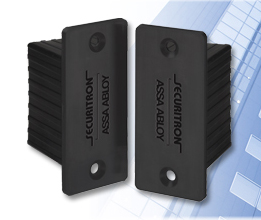The door hardware industry breathlessly awaits the debut of Securitron’s new PowerJump ICPT™ Inductive Coupling Power Transfer. The PowerJump is Securitron’s miraculous new device that may put a significant dent in the electric through-wire hinge market. I mean, why would you drill a half inch hole the width of a 36-inch door when you could install this little pair of black boxes on the lock side?
I downloaded the installation instructions from the Securitron web site to check out product attributes and characteristics. The first thing I noticed, having spent much of my career working with wooden doors, that the Securitron PowerJump ICPT is a bit friendlier to a hollow metal door or frame install than it is to a wood door or frame install. Because the body of the unit is almost the same size as the face, the installer must take great care to cut a very clean hole for the body so that the hole does not exceed the size of the face. This can be a little tricky when using a speed bore bit (or auger bit as mentioned in the instructions) to drill the two deep holes for the mortise pocket before cutting in the face.
One trick I have used to use when installing mortise locks was to cut in the face first and get that nice and clean before drilling the holes. I had good success with this because it gave me a very clear outline to stay within – much like coloring inside the lines with crayons in kindergarten. Installing the PowerJump is a lot like installing a really small mortise lock, actually. The face is the same width and a standard architectural grade mortise lock – 1-1/4 inches.
The PowerJump ICPT draws 500mA at 24 volts DC on the frame side, will transmit it across up to 3/16 inch of empty air and output either 250mA at 24VDC or 500mA at 12VDC on the door side. 500mA seems a little slim to be powering an electrified mortise lock. Usually I like to see a bit of a cushion when it comes to current, so I would usually not power a device that requires 250mA at 24 volts DC, like a Sargent electrified mortise lock, with a power source that provided no more than the 250mA required. I’d be a lot happier with a power source that has a capacity at least 1.5 times as great as the appliance being powered.
However, the average electrified hinge with 28-gauge through-wires only has a current rating of about 160mA and we have been powering electric mortise locks with these for decades. Since I am not an electrical engineer I am not sure how that works, but it does. I am also mystified by the science behind transmission of electrical current by induction. Therefore, like most installers, I trust Securitron to produce yet another innovative product that works well. I’ll be waiting to hear how installers like it when it is finally released. I know I’ll hear about it one way or another.
access control, alarm, builders hardware, door hardware, electric latch retraction, electric locking, electronic security, power supply, security hardware


{ Comments are closed! }